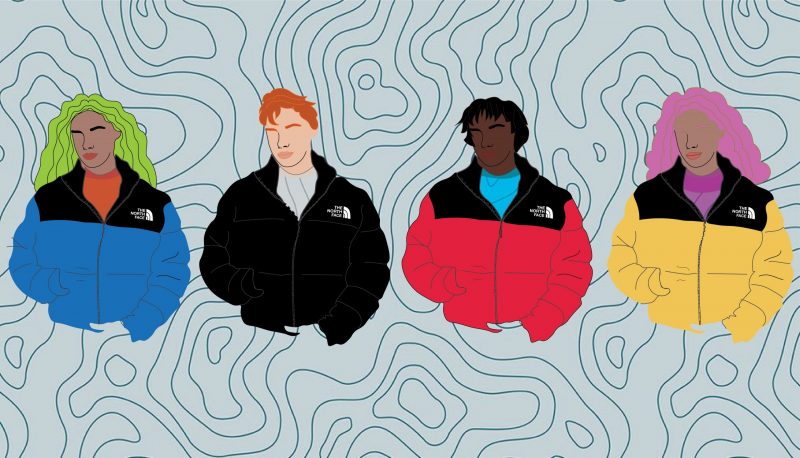There you are, standing at Berri-UQAM station surrounded by a sea of The North Face puffer jackets: black, red, cobalt blue, bright yellow, purple. They’re everywhere, with people’s tiny heads poking out from a mass of down-filled, quilted, nylon jackets. Why?
Typing “why does everyone wear…” into the Google search bar will yield a variety of laughable results: Blundstones, The North Face and jeans are among the first few. These fashion items may seem average right now, but in 10 years or so they will be a thing of the past—matching American Apparel disco pants and scrunchies… anyone?
But this isn’t anything new; it’s just how trends work. Trends have been around for hundreds of years and are studied across numerous fields including sociology, art history and psychology. The people waiting in line in their puffer jackets may appear to be a flock of sheep now, but really, they are a marker of a generation and an indication of current socio-political, cultural and economical stressors. Let’s break this down.
Many factors contribute to the growth of a trend, and it is not only celebrities and red-carpet styles. In fact, there is a lot more that goes into it than you may think. Estimated at a value of USD $1.3 trillion in 2015, the global apparel market consists of a plethora of players including suppliers, manufacturers and designers. Other than these, entire enterprises like WGSN are devoted to analyzing and forecasting trends years in advance. Meaning, the predictions for this season (Spring/Summer 2020) were probably getting finalized around this time four years ago, in 2016.
Some trends last a couple of months while others last years. This is called the “life cycle” of a trend. Trend-cycles—or product life cycles—are used in many industries to represent frequency fluctuations over time. In this case, the beginning of the cycle, or “introduction,” might be a group of attendees at Pride wearing rainbow-striped platform shoes. In the “growth” stage, this will have caught the eye of a celebrity, Janelle Monáe for example, who will wear a striped Pride gown at the 2018 BET Awards, in addition to a few other avant-garde individuals.
By now, rainbow coloured and patterned items have reached the “maturity” stage of the life-cycle and can be seen everywhere, from Susan Alexandra accessories, which has had a big Instagram moment in the past year, to The Last Line, who have become known for their colourful, timeless and affordable jewelry designs.
When the item begins its “decline” in popularity, it is no longer seen as being trendy but is not yet rendered obsolete. Think UGGs, for example. While they are no longer a “big deal,” you still see them around every now and again. A product that has passed the “decline” stage is no longer trendy and very difficult to come by, like elbow-length gloves.
But just how do these items get trendy?
The Business of Fashion and management consulting firm McKinsey & Company’s The State of Fashion 2020 report, titled Navigating Uncertainty, analyzes themes in the current fashion economy, in addition to explaining the industry’s driving factors. Among them are cross-border challenges as international competitors grow, sustainability via the exploration of alternative materials, and social responsibility in regards to inclusivity and diversity. These shifts are likely to impact consumer trends within the fiscal year.
While that Patagonia half-zip you’ve been seeing everywhere is cute, it is not a trend solely because of its looks. In a time of ecological crisis, sustainability and social responsibility have become an increasing focus for consumers. Thus, it is no surprise that environmentally and socially-conscious brands are gaining momentum. Trends are a response to our environment and a means of expressing how we feel.
As our generation acquires more purchasing power, an increasing amount of outdoor brands will outgrow traditional brands. The rising popularity of The North Face and the resurgence of L.L. Bean are not coincidental. Brands like Carhartt that were once reserved for construction-wear, have now made it onto the runway, through collaborations with brands like A.P.C.
Athletic and outdoor recreation brands, like Outdoor Voices, have gained popularity as experiencing and spending time in nature become increasingly covetable activities. Wellness and experience are of great value to Millennials and Gen Z. Utilitarian items like fanny packs, trench coats and sneakers from brands like Patagonia will continue to gain momentum among consumers with an increased interest in functional design and in reducing their ecological footprint.
A variety of books, articles and academic journals are devoted to studying the life-cycle of trends and their history. This piece in no way conveys the magnitude of what they can show or how they come to be. But maybe, next time you put on those sneakers or feel the urge to buy that hoodie you’re seeing everywhere, you’ll take a moment to think about why it might be so popular. Take a second to reflect on why you might be seeing outdoor and camp-inspired garments everywhere—you’d be surprised at what you might come up with.
Graphic by Sasha Axenova
